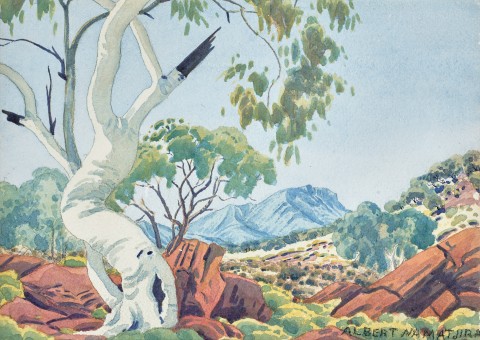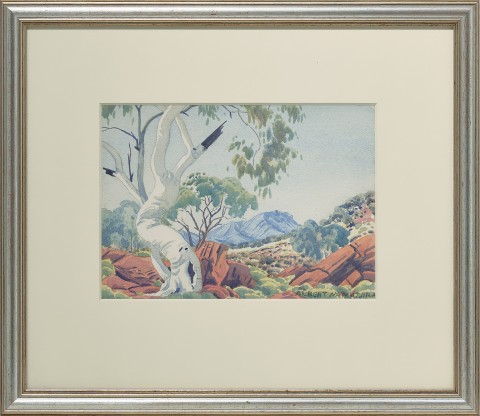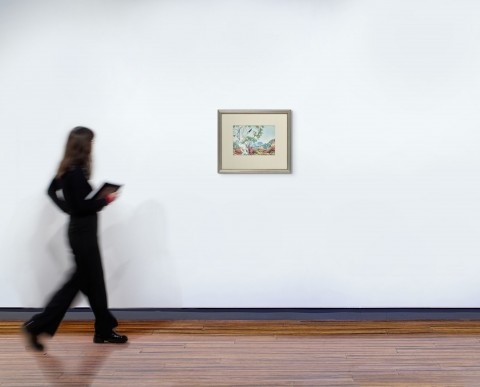GHOST GUM, CENTRAL AUSTRALIA, 1951
ALBERT NAMATJIRA
watercolour and pencil on paper
26.0 x 37.0 cm
signed lower right: ALBERT NAMATJIRA
bears inscription on sheet verso: 17/4/51
Acquired by Denis Connors (Newcastle Waters Station, NT), acquired in the early 1950s
Thence by descent
Private collection, Melbourne, acquired c.1960
Thence by descent
Private collection, Melbourne, acquired in 2001
Albert Namatjira’s painting of the central Australian landscape was both innovative and personal. However, contained beneath the cover of the western artform, the artist also made claim to his country, plural meanings can be seen to have existed within his paintings. His landscapes can also be read as memories of an ancestral site and through the reiteration of the subject, a claim of ownership is subtly asserted. Gum trees and mountains feature prominently in Namatjira’s work and Ghost Gum, Central Australia, 1951 is a prominent example of both a familiar subject to the viewer and a statement of belonging by the artist.
Like much of Namatjira’s finest works, this watercolour evokes the artist’s distinctive compositional device with his much-loved, luminous white Ghost Gum typically dominating the foreground, and silhouetted against a dramatic rocky foreground of red and purple tones and the distant mountain ranges in blue. The Ghost Gum (Eucalyptus papuana), both the painting’s focus and a pointer to the distant landscape, is an incredibly hardy species. Known as ilwempe to the Western Arrernte, it grows in extraordinary inhospitable conditions and features in Aboriginal creation stories, in which individual trees can be considered to represent ancestral beings.1 Balanced on the left side of the composition and reaching beyond the picture, the majestic gum plays a pivotal role not only as a framing device and point of entry into the picture plane. More fundamentally perhaps, the signature cropped tree motif creates a tangible sense of being present in the landscape, of participating alongside the artist in seeing and identifying with the land – thus imbuing the work with an unmistakable intimacy.
Through a combination of deep ancestral connection to Arrente country and his extraordinary compositional skills in representing country and the changing effects of the light, Albert Namatjira inspired a school of painting, having a major impact across Australia and creating some of the earliest bridges between Aboriginal and western cultures, which were to be reinforced by later forms of desert art.
1. French, A., Seeing the Centre: The Art of Albert Namatjira, 1902 – 1959, National Gallery of Australia, Canberra, 2002, p. 121
CRISPIN GUTTERIDGE


